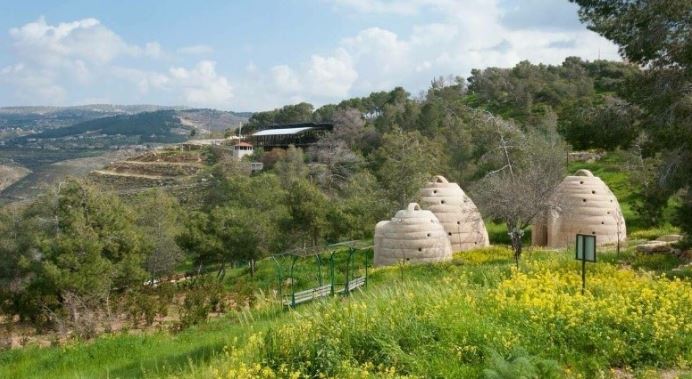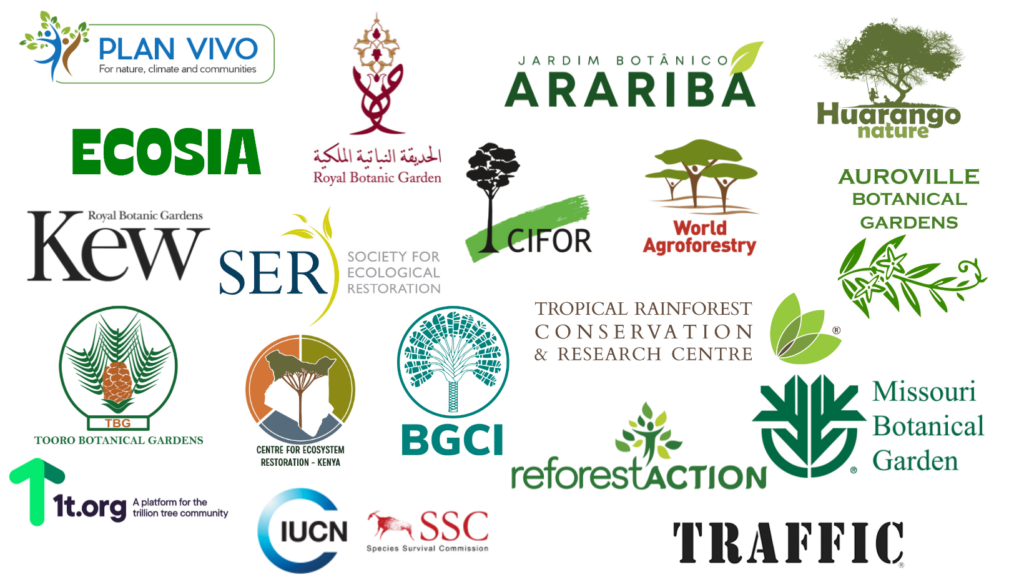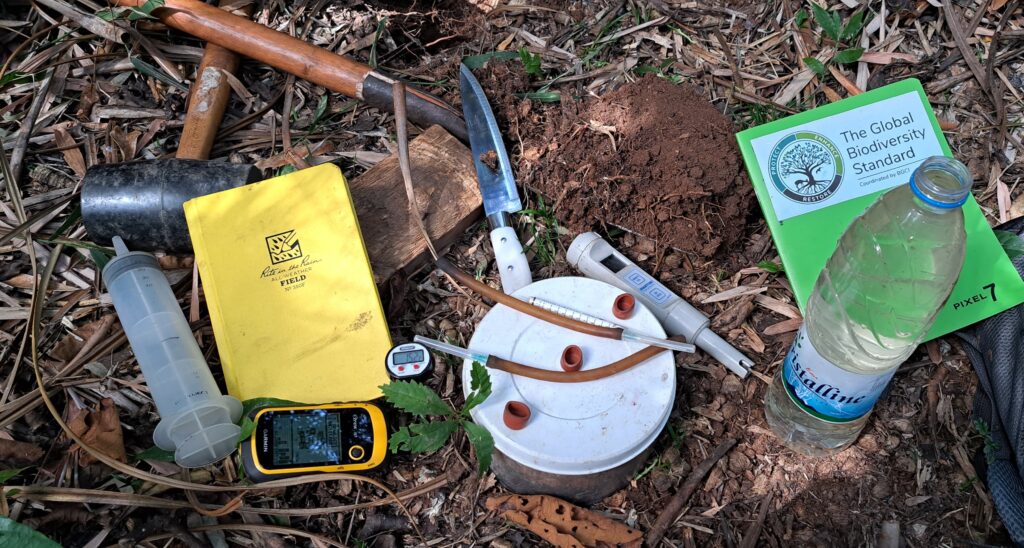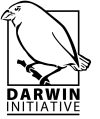An update on the Global Biodiversity Standard for November 2023 – exciting progress happening around the world.
An update from The Global Biodiversity Standard Manager
The last six months have seen considerable advancements with the development of the Global Biodiversity Standard (GBS). Our hubs have been busy testing the latest version of the assessment methodology at over 20 sites across six countries. This now takes the testing of the GBS to over 100 sites! We also launched a technical consultation and received feedback from over 60 experts in ecosystem restoration, remote sensing, land management, forestry and global policy and frameworks. I’d like to say a big thank you to everyone who contributed to this technical consultation and helped us improve the GBS methodology. Our technical partners have been busy updating the method based on this feedback, resulting in a stronger, more robust assessment methodology. Watch this space as the full technical specifications of the GBS get published in the coming weeks.
The last six months have also seen the expansion of the GBS team. The Tropical Rainforest Conservation & Research Centre, Malaysia (TRCRC) and the Royal Botanic Garden, Jordan have joined our network of hubs. You can read about these new hubs below. It is very exciting to see our hub network become increasingly global as it now spans across 3 continents and covers 8 of the most biodiverse regions on Earth. We have also started to receive support from the Acorn team at Rabobank and Bioflore in the development of the remote sensing surveys method. In collaboration with Reforest’Action, they have helped realise major improvements to this component of the GBS. JS Global Advisory are another addition to the team, helping to support us develop a sustainable, non-profit business model. They are also running a survey to gain feedback on the GBS via our public consultation.
It has also been exciting to hear about the promotion of the GBS across many events globally. Our team has been showcasing the GBS at SER 2023 in Australia, at GEOBON 2023 in Canada, at the Global Landscapes Forum in Kenya, at the Alliance for Nature-Based Solutions conference in Brazil and at the RedLAC conference in Peru. We thank everyone who has attended and provided feedback at these events. We also hosted a webinar to introduce the standard and its assessment methodology. This is still available to watch for anyone who missed it.
The next few months promise to be just as busy and exciting. The publication of the GBS manual is just around the corner, as is the training of our first cohort of GBS assessors. All of the technical and hub partners will convene for two weeks at Jardim Botânico Araribá in São Paulo, Brazil, for this training. We will also be continuing to showcase the GBS, including at the upcoming 1t.org corporate alliance meeting.
I hope you enjoy reading all about our activities from the last six months and please do help support our public consultation!
David Bartholomew, Global Biodiversity Standard Project Manager

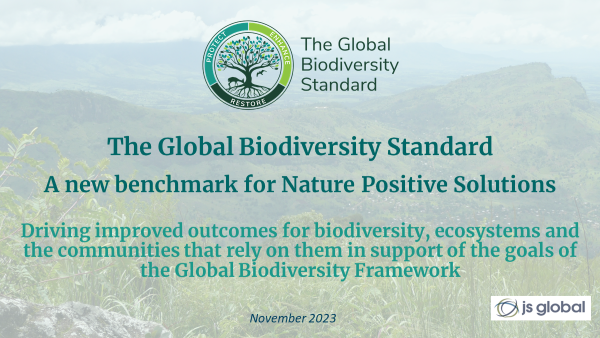
Launch of public consultation for The Global Biodiversity Standard
By Paul Stuart-Smith (JS Global Advisory)
The Global Biodiversity Standard (GBS) consortium of partners is excited to announce the launch of a public consultation to obtain feedback about the Global Biodiversity Standard. This important new initiative aims to drive improved outcomes for biodiversity, ecosystems and the communities that rely on them in support of the goals of the Global Biodiversity Framework. All readers of this newsletter and all members of GBS partner organisations, as well as potential users of the GBS and other stakeholders are invited to participate. You can find out more about the GBS by taking a look at the short summary document here.
The consultation marks an important step in the development of the GBS and is being conducted ahead of a planned public announcement at COP28 to herald publication of the GBS technical specifications. COP 28 takes place in the UAE beginning on 30 November.
The consultation consists of 10 questions, each of which can be easily answered on a sliding scale from 0 to 10.
It needs only take a few minutes to complete.
Please click here to take part.
We look forward to receiving your insights and feedback.
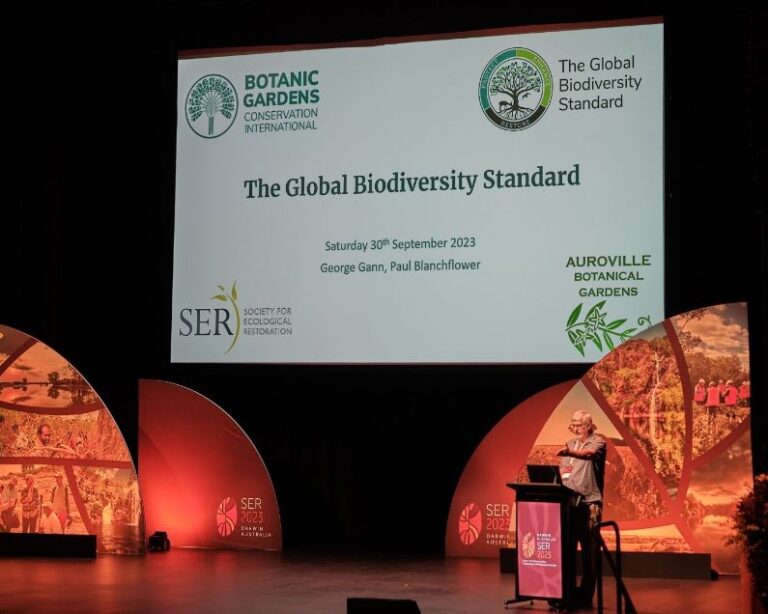
The Global Biodiversity Standard at events worldwide
Auroville Botanical Gardens and SER represent the GBS at the SER 2023 conference and Fifth Global Forum on Ecological Restoration.
By Paul Blanchflower (Auroville Botanical Gardens; GBS-India HUB)
The SER conference in Darwin was held in the last week of September. It was a great conference, with an extraordinary program. The choice of presentations, workshops, and meetings was wide, and the delegates were an amazing group of people to interact with. There were over 1000 people attending in person, nearly 600 oral presentations, more than 40 symposia, 22 workshops as well as a number of side events. The theme of the conference “Nature and People as One: Celebrating and Restoring Connection” was a profound and timely call to action with respect to community involvement in all aspects of restoration, and it was well supported by the keynote presentations in the plenary sessions. Of particular note amongst these were Kia Dowell who spoke about her involvement as a Gija woman from the Warmun Community involved in the decommissioning of a mine in her ancestral area, Sera Gibson from the Taranaki region of New Zealand who spoke about the restitution of Taranaki Maugna to the Maori community and Marina Best who spoke about the work she does with the Michif in Canada.
The conference was also an excellent opportunity to understand the current scenario with the UN Decade of Restoration – with the release of the new guidelines associated with this for restoration and also to align with current thinking in the sphere of Nature positive accounting, scaling up restoration and involving corporates in the process.
Prior to the conference I attended the Fifth Global Forum on Ecological Restoration which was focusing on creating guidelines for the social aspect of restoration. This was attended by around 40 people and will be an ongoing process that will stretch over the next 18 months. During the conference George Gann introduced the Global Biodiversity Standard at the plenary session on the last day. He did a great job – as he did throughout the conference with the various interventions and presentations he made.
I would say a small percentage of attendees were already aware of GBS, the majority of people were in agreement that this kind of approach is useful, however there were questions raised wondering how such a standard can be implemented over such a wide range of projects. However, all the conversations were engaging and people in general had a very positive interest in the work.

Monitoring Biodiversity for Action: The GBS at GEOBON 2023
By David Bartholomew (Botanic Gardens Conservation International)
The Global Biodiversity Standard (GBS) was represented at the Global Earth Observation Biodiversity Observation Network (GEOBON) conference held in Montreal. Almost one year on from the momentous declaration of the Kunming-Montreal Global Biodiversity Framework at COP-15, the conference marked a moment for scientists to come together to discuss how to monitor progress against the targets.
Held in the second week of October, the four-day event included more than 300 presentations, over 100 posters and daily workshops and panel discussions. The conference was opened with a speech from Otsi’tsaken:ra Charles Patton, an Elder from the Kanien’keha:ka Community of Kahnawake – an indigenous Quebec community. He spoke of the connection that humans have with nature and the need for non-indigenous populations to restore this connection. The day continued with a range of talks including how to implement improved biodiversity monitoring into policy. The day also featured a workshop on identifying key indicators to monitor change. This session highlighted the need for a new indicator to monitor change over short time periods at the site-level: a key ambition of the GBS.
Day two of the conference began with a keynote from Prof. Jeannine Cavender-Bares who spoke about the great potential of remote sensing to monitor biodiversity. She spoke of the great potential that remote sensing has to contribute to biodiversity monitoring, but also highlighted the need for ongoing field surveys. The rest of the day focused on the use of modelling and technology to monitor biodiversity and included a workshop on acoustic sensors, one of the methods encouraged in the GBS assessment process. The day ended with a poster session and an opportunity to discuss diverse novel advances in biodiversity monitoring.
On day 3, the GBS was showcased in the symposium on Remote Sensing for Biodiversity Monitoring. David Bartholomew from Botanic Gardens Conservation International (BGCI) presented the GBS methodology and the potential and limitations for remote sensing to support the monitoring of ecosystem integrity, including biodiversity. The talk also showcased how the field surveys of the GBS can contribute to ground truth latest developments in remote sensing.
The E. O. Wilson Foundation hosted Half Earth Day on the afternoon of day 3. The day is named in honour of E. O. Wilson’s proposal that half of Earth’s area should be designated as human-free natural reserves to preserve biodiversity. The event was opened by the president of the E. O. Wilson Foundation and Louie Psihoyos, an Oscar-winning filmmaker and National Geographic photographer, who talked about the need to engage the public to drive change for nature. The afternoon followed with various panel discussions on topics that included the impacts of wildfires, how to safeguard species and how to convert knowledge into action. The event ended with an empowering speech from Wade Davis who spoke of how humanity should learn from the thousands of indigenous cultures who manage to live in harmony with nature.
The GEOBON 2023 conference ended on day four with more presentations and panel discussions, including how to produce monitoring in support of nature finance. Overall, the event showed the great potential we have to monitor biodiversity, but the real need to implement solutions to drive improvements for biodiversity. Hopefully the Global Biodiversity Standard can make a key contribution to advancing our ability to monitor positive actions for biodiversity!

BGCI and the Center for Ecosystem Restoration – Kenya showcase the GBS at the Global Landscape Forum
By Jonathan Jenkins (Center for Ecosystem Restoration – Kenya; GBS-Kenya HUB)
The Global Landscape Forum (GLF) is an event that brings together people from different backgrounds to discuss and share ideas on how to achieve a sustainable future. The GLF serves as a platform for networking, establishing connections and finding common ground for collaboration. This year’s forum was facilitated by the International Center for Research in Agroforestry (ICRAF) and was attended by 120+ speakers and representatives from 74 organizations, who participated in 38 different sessions. The forum was characterized by a diverse range of discussions, including networking sessions, thematic and plenary discussions, and interactive dialogues.
The first day was marked by a networking session, characterised by random pairings, facilitated discussions on critical themes under the leadership of ICRAF, focusing on fire, land, and water. Throughout these thematic discussions, participants reflected on the individuals and communities that had played pivotal roles in their journey as Global Landscape leaders, including mentors and teachers to friends and restoration champions, underscoring the diversity of support systems in the sustainability sector. Moreover, it was also an opportunity to share our organisation’s objectives, linking them to the overarching mission of the Global Landscape Forum. This exchange allowed for a deeper understanding of each other’s work and laid the foundation for potential collaborations and shared initiatives.
The GLF further delved into the critical topic of local action driving policy change through dedicated sessions. Policy experts and advocates from GLF, Youth in Landscapes Initiative, GLFx Chapters, and partners shared their insights on strategies to propel restoration initiatives into policy-making. The discussions highlighted the importance of harnessing local knowledge and expertise in shaping policies that can drive meaningful change on a global scale.
Another crucial aspect of the GLF was the emphasis on African-led solutions for transforming food systems and restoring landscapes. These solutions highlighted the need to be tailored to address the unique challenges faced by the African continent in achieving sustainability goals. Further, the panellists’ discussions highlighted the crucial role of seed banks in preserving genetic diversity, which is essential for ensuring sustainable agricultural practices in the face of a rapidly changing climate. The significance of seed diversity was emphasized for developing more productive, nutritious, and resilient crops that can meet the challenges of climate change, degraded agricultural lands, and a growing population. The discussions also shed light on the challenges faced by gene banks, including insufficient staffing and low levels of funding. To address these challenges, organizations like the Seeds for Resilience project are providing financial and technical support to ensure that national gene banks meet the necessary international standards to keep their collections safe and widely available in the long run.
The GLF’s dedication to restoring landscapes and fostering deforestation-free supply chains, particularly by smallholder farmers, exemplified the discussed practical strategies. These conversations revolved around the environmental advantages and the economic and social dimensions of restoration, underscoring a comprehensive approach. One notable approach involved integrating tree nurseries as a restoration component for farmers, by empowering them to establish their own nurseries and acknowledging their local knowledge. The tree nurseries also played a pivotal role in shaping discussions on deforestation-free products, with initiatives aimed at commercializing nurseries and empowering farmer models and trainers, benefiting both national and regional agricultural communities.
On the second day of the GLF, we witnessed the exploration of Africa’s future through locally-led landscape restoration. These discussions underscored the vital role of local communities and initiatives in shaping a more sustainable future for the continent. For instance through halting conversion of rangelands, strengthening global coalitions and platforms that support and provide opportunities for collective and inclusive dialogue towards sustainable community resource management and revitalizing practices and indigenous knowledge. Additionally, sessions on mobilising finance through innovative payment for ecosystem services schemes highlighted the importance of sustainable financing models to support restoration efforts.
The GLF also spotlighted the efforts of young people and communities in the Global South in the “Stewarding Visions of Justice and Restoration” session. This gathering showcased youth and community-led grassroots actions for holistic landscape restoration. It brought attention to initiatives such as GLF’s Restoration Stewards and Chapters and UNCCD’s Land Heroes, highlighting the critical role of young individuals and communities in driving sustainability efforts.
Throughout the day, there were guided tours of the high-tech laboratories at the CIFOR-ICRAF, which included visits to the GIS, soil, dendrochronology, and seed labs. Of particular note was the soil laboratory, where advanced technology is employed to analyse soil, plants, and agricultural inputs using dry spectral methods. Furthermore, they have made significant strides in developing the Land Degradation Surveillance Framework (LDSF), which offers a scientifically based field protocol for assessing the characteristics of land soil and monitoring changes in vegetation composition and land degradation status over time. This framework utilises data from various global sites to generate predictive mapping outputs at multiple spatial scales, enabling zooming into a specific site area and assessing the possible indicators.
As the Center for Ecosystem Restoration – Kenya, we had the opportunity to showcase our work through an exhibition booth, showcasing a selection of seeds from our seed bank and sharing insights into our extensive restoration efforts. We particularly highlighted our implementation of the Global Biodiversity Standard within the Coastal and Highland regions. Our work resonated with attendees due to the different range of ecosystems we engage with and our holistic approach, bridging scientific expertise and traditional ecological knowledge.
In conclusion, the GLF fostered connections, inspired change, and furthered the collective mission toward a more sustainable future.
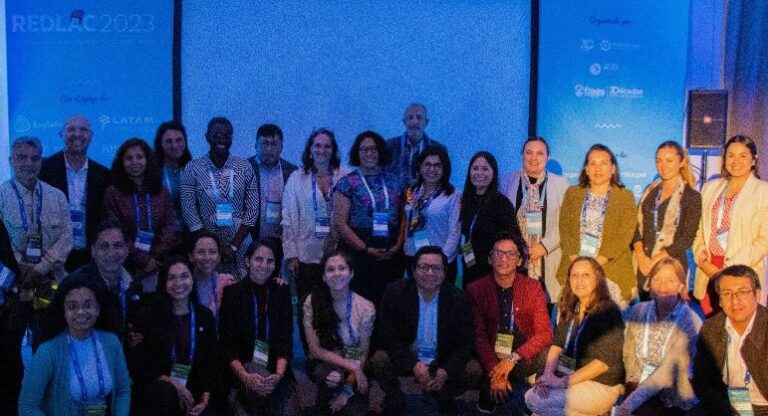
GBS representation at the largest Latin-American and Caribbean network meeting for environmental financing
By Gaby Orihuela (Huarango Nature, GBS-Peru HUB)
Our representative from the GBS-Peruvian HUB took part, from October 23rd to 25th, of the 25th International Congress of the Latin American and Caribbean Environmental Funds Network (RedLAC) in the city of Cusco, Peru. Nineteen countries gathered to address topics aligned with global conservation objectives. Representatives led conferences, panels, and workshops discussing the need for innovation in sustainable development, the importance of capacity building, and new ways to manage knowledge during a time when our planet faces a triple crisis and a point of no return.
Biodiversity management and conservation have a new tool in the GBS, a crucial instrument for managing areas in the process of restoration, involving local communities as key contributors, since they voluntarily participate in the conservation of natural resources and protected areas as it was emphasized during these three-day sessions. It was also highlighted that one of the key processes requiring significant attention and funding is Monitoring and Evaluation, to guarantee that real work is being done, measuring results instead of following the paper-parks practice, and aligning with our mantra: “the right tree in the right place.” The scientifically based methodology used by the GBS will provide assurance to investors while adding value to processes and natural products, ensuring a genuine and measurable improvement towards biodiversity.
This annual congress brings together influential stakeholders responsible for developing financial mechanisms that generate measurable impacts on local, regional, and global scales. Some have already been introduced to the GBS proposal, we hope to gain more allies as we strengthen our initiative.
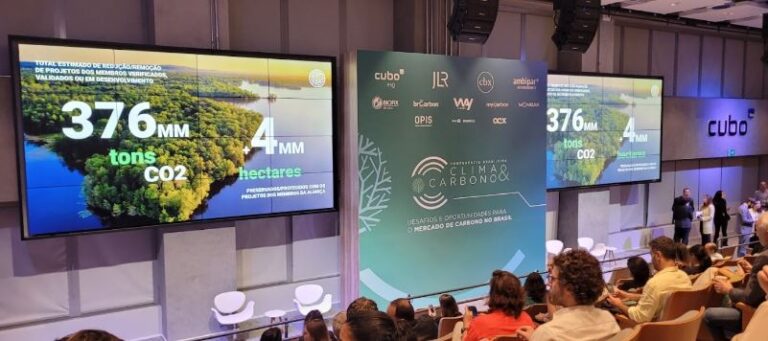
Unlocking Synergies: Global Biodiversity Standard in Brazil
By Luiz H R Baqueiro (Araribá Botanical Garden; GBS-Brazil HUB)
In October, the Global Biodiversity Standard was represented by the GBS’ Brazilian Hub, Luiz H. R. Baqueiro from Araribá Botanical Garden and David Bartholomew, GBS Project Manager, at the 1st “Climate & Carbon” Brazilian Conference – Challenges and Opportunities for the Brazilian Market. The event was organized by the Nature-Based Solutions Brazil Alliance in São Paulo, Brazil.
Established in 2021, the Nature-Based Solutions Brazil Alliance aims to combat deforestation and environmental degradation in Brazil by strengthening nature-based solutions and the carbon credit market. The organization’s central focus is on establishing guidelines and best practices to uphold sector integrity.
It brings together key stakeholders that collectively are responsible for over 70% of Brazilian credits issued since 2022, related to NBS and AFOLU (Agriculture, Forestry, and Other Land Use).
The alliance’s mission is to bring together professionals and key stakeholders with a vested interest in climate change and the burgeoning carbon market. Three focal points guided the panels: climate, carbon markets (regulated and voluntary), and the outlook for COP28.
The conference explored vital topics, including community engagement strategies, compliance with existing carbon market certification criteria, financier interest in this market, and the evolving regulatory landscape of both voluntary and regulated markets.
One of the Nature-Based Solutions Brazil Alliance’s pivotal objectives is to promote sector integrity through industry guidelines and best practices. Additionally, their efforts are aimed at combating deforestation in Brazilian forests, the primary source of emissions in the country, and reinforcing programs for land rehabilitation and use transitions—essential tools in the fight against climate change and the preservation of biodiversity.
This alignment of goals between the GBS and the Nature-Based Solutions Brazil Alliance fosters a powerful synergy, serving their shared mission. Significantly, the GBS introduces an innovative approach, translating biodiversity change assessment into quantifiable data — a crucial requirement acknowledged by conference key speakers. As GBS navigates the convergence of conservation and business goals in biodiversity and climate action, it is poised for a pivotal role in the coming years.
Developing and testing the GBS methodology
Finding reliable, standardised, objective and cost-effective protocols for tracking ecological recovery in tree planting projects in Madagascar
By Narindra Ramahefamanana (Missouri Botanical Gardens Madagascar Program; GBS-Madagascar HUB)
Field evaluation of ecosystem integrity is of central importance to GBS certification of tree planting projects and, to date, the identification of viable evaluation protocols has been a key preoccupation of the six GBS hubs.
The challenge is to define standard evaluation protocols that reliably provide quantifiable data on the condition of an ecosystem, and how it changes over time. Importantly too the protocols must be scientifically valid yet quick and cheap to apply. If the evaluation is too expensive then GBS certification would be accessible only to wealthy tree planting projects. Initially, staff in the GBS Madagascar hub relied heavily on expert opinion in making evaluations but, whatever the level of expertise, subjective data does not provide the required transparency. Hence, we have worked to develop a basket of simple but eloquent protocols that together provide an objective evaluation of the ecosystem integrity of sites.
Typically this data is compared to a second set of measurements taken in the designated reference ecosystem. The sampling is stratified and based on 0.1 ha plots that are installed over the target landscape (and reference ecosystem). In each 50 x 20 m sampling unit the survey team: inventory native and alien woody plant species; describe the structure of the vegetation; count tree seedlings (i.e., regeneration) in replicated nested sub-plots; count felled trees and estimate the area within the plot burnt or converted to agriculture. Within these transects the permeability of the soil is measured and soil samples are taken to measure pH and later (through combustion) carbon content. Pits are dug and watered with mustard solution to estimate the abundance of earthworms in the soil and methods are being explored to provide a more detailed inventory of soil fauna by placing a soil sample below a heat lamp and collecting, identifying and weighing the animals fleeing the heat (Berlèse method). A fixed-point drone image is taken at the central point of each plot (to enable visual tracking of changes of the vegetation over time) and, more widely, transect walks are made to describe avian diversity and abundance. We consider that together, and with sufficient replicated sampling, these attributes can provide a reasonable evidence-based assessment of ecosystem integrity.
Two new databases developed to support GBS assessments
By Roeland Kindt (World Agroforestry Centre)
In August, two articles were published under a open-access license that describe the GlobalUsefulNativeTrees (GlobUNT) and Tree Globally Observed Environmental Ranges (TreeGOER) databases.
Both these databases were developed with cofunding from Darwin Plus (The Overseas Territories Environment and Climate Fund) (Grant No. DAREX001). If you wish to learn more about these databases, then you are invited to read these articles – and then hopefully give the databases a try.
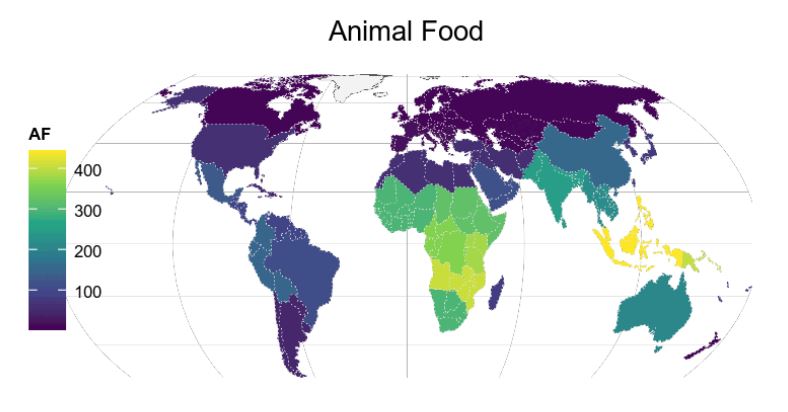

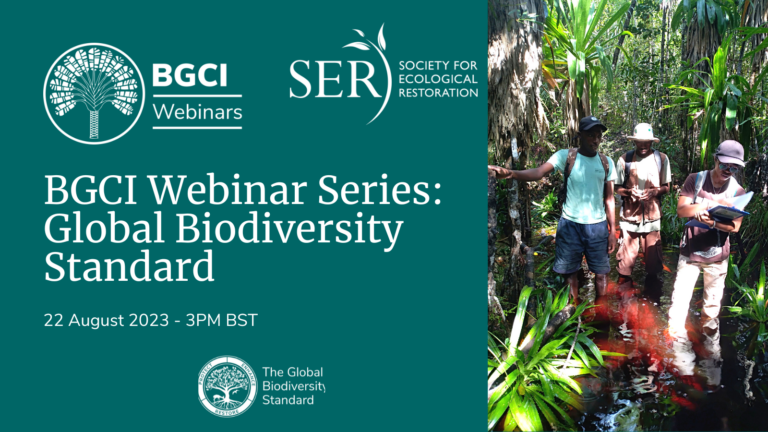
The Global Biodiversity Standard Webinar
By David Bartholomew (Botanic Gardens Conservation International)
The Global Biodiversity Standard (GBS) team led a webinar on the latest version of the assessment methodology in August 2023. Hosted by the Society for Ecological Restoration (SER), the webinar started with an introduction to the standard by David Bartholomew from Botanic Gardens Conservation International (BGCI). The rationale for the GBS, the eight criteria and timeline for the GBS development were outlined in this introduction.
George Gann from SER then explained how the criteria will be assessed. The method incorporates various SER tools that have been developed in support of best practices for ecosystem restoration. George presented the SER recovery wheel and how this is used to score sites for their biodiversity impacts.
Social benefits and stakeholder engagement are also assessed under the GBS. Caroline Stillman from the Plan Vivo Foundation introduced how the GBS assesses these impacts and introduced the exclusion list that is adapted from Plan Vivo’s standards.
The webinar ended with an introduction to the GBS manual by Amarizni Mosyaftiani, an SER Restoration Fellow. She highlighted how the manual presents standardised and complementary methods to be used by assessment teams. The manual is currently under development, with its publication scheduled for December 2023.
The webinar is available to watch on the BGCI webinar library.
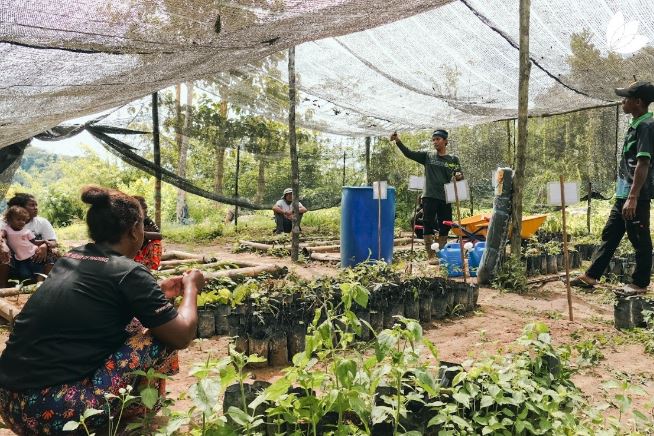
Two new hubs join the Asian GBS network
By Adrihani Rashid (Tropical Rainforest Conservation & Research Centre)
TRCRC become our new Malaysian hub
Tropical Rainforest Conservation & Research Centre (TRCRC) is a Malaysian NGO focusing on the restoration of tropical rainforests and addressing the critical rate of biodiversity loss in Malaysia.
Established in 2012, TRCRC has spent over a decade on their two-pronged mission: to conserve tropical rainforest plant species; and to lead landscape-wide protection and forest restoration projects. Over the years, TRCRC has established Tropical Rainforest Living Collections (TRLCs) in 3 different states across the nation.
These Living Collections, or TRLCs, house a living gene bank of species from the iconic Dipterocarpaceae family, a keystone group of species in Malaysian rainforests. Of the 357 species within this family, 67% are Threatened in the wild, with 211 of the species found in Malaysia considered as threatened species. TRCRC’s efforts focus on securing conservation of globally and locally threatened Dipterocarpaceae within the states of Sabah, Perak, and Selangor, with goals to expand the conservation efforts across the nation. The TRLCs mark a crucial endeavour to secure native biodiversity both at a species as well as a genetic level, in line with the organisation’s commitment to protect these species from extinction.
Across the 3 TRLCs, the collections house 54 Families, 117 Genera, 175 Species, and counting. Of these species, 61 are under threat of extinction – according to the IUCN Red List, the collection houses 12 Critically Endangered, 18 Endangered, 31 Vulnerable, and 19 Near Threatened species.
Each TRLC houses a provenance-specific collection of these threatened dipterocarp species to ensure that in the long run, high conservation value planting material with wide genetic adaptations can one day be reintroduced to their native regions through community-based forest landscape restoration efforts. TRCRC works closely with other NGOs, community groups, schools, universities, government agencies, and other relevant stakeholders on skill sharing and capacity building to ensure meaningful partnerships towards shared goals of ecosystem restoration.
RBG, Jordan become our new Jordanian hub
The Royal Botanic Garden (RBG) was founded as a non-governmental, non-profit entity in 2008 to conserve the native flora of Jordan. RBG’s mission is to ensure native flora conservation through ecological restoration and providing research and a demonstration site to address the environmental challenges of our times and generating hope for the future.
The RBG envisions a society where there is no longer a need for plant conservation. Where the interdependency between people, plants and ecosystems is well understood, and where all Jordanians are assured of a dignified and sustainable life.
In the course of its work, the RBG is working closely with the government to reach certain goals in order to meet Jordan’s commitments to the Convention of Biological Diversity. Establishing a botanic garden is part of the biodiversity strategy and action plan prepared by the Ministry of Environment to implement the 1992 Convention on Biological Diversity, ratified by Jordan in 1993.
The Garden site is fortunate to have a large number of plants that grow naturally, where the site contains more than 600 plant species. Furthermore, the importance of the site is the range of altitude which allows the possibility of hosting the majority of the species growing naturally in Jordan which can represent elements of the four biogeographic regions. This provides the ongoing opportunity to restore and manage five major habitats: Pine Forest, Deciduous Oak Forest, Riparian Freshwater Habitat, Juniper Forest, and Jordan Valley and Dead Sea Habitat.
Finally, it is worth mentioning that RBG is the national focal point for the Global Strategy for Plant Conservation (GSPC) and has taken on the responsibility in achieving specific targets of the Convention on Biological Diversity (CBD), publishing Jordan Plant Red List and Annotated Plants Checklist.
